|
China Burning
China has been bright red on the SO2 charts for over a year now
from ripping rock releasing Methane and the CO maps show it is
also burning this Methane. Was this predicted by the Zetas? Yes,
in 2010. The 7 of 10 Plate Movements detailed
in 2010 stressed that Plate Movements are intertwined, so
movements occur in a domino fashion, rolling from West to East.
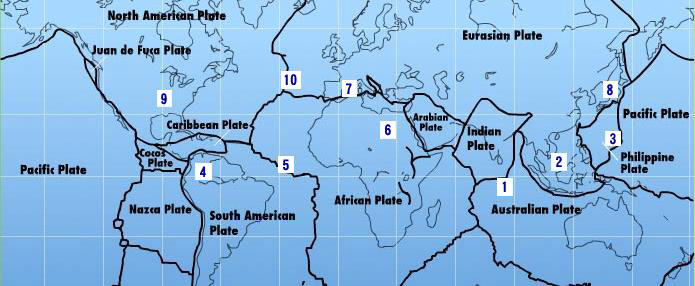

As noted on the graphic, point (7) occurred when the Venice
Canals and the beaches of Tel Aviv went dry on the same day last
February 19. As depicted on the
graphic, the Zeta sequence in the 2010 Plate Movements is as
follows:
(1) a tipping Indo-Australia Plate with (2) Indonesia sinking,
(3) a folding Pacific allowing (4) S America to roll,
(5) a tearing of the south Atlantic Rift allowing (6) Africa to
roll and (7) the floor of the Mediterranean to drop,
(8) great quakes in Japan followed by (9) the New Madrid
adjustment,
(10) which is followed almost instantly by the tearing of the
north Atlantic Rift with consequent European tsunami.

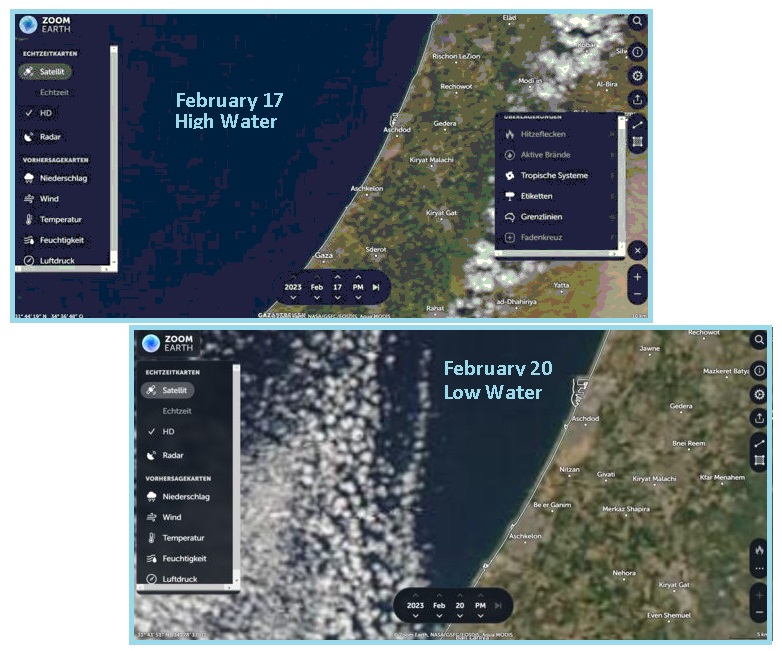
ZetaTalk Prediction10/16/2010: The
sequence of events is, thus: a tipping Indo-Australia Plate
with Indonesia sinking, a folding Pacific allowing S America
to roll, a tearing of the south Atlantic Rift allowing Africa
to roll and the floor of the Mediterranean to drop, great
quakes in Japan followed by the New Madrid adjustment, which
is followed almost instantly by the tearing of the north
Atlantic Rift with consequent European tsunami.
Thus the Zetas laid out the timeline showing that massive quakes
in Japan would be the next step prior to the New Madrid
Adjustment. The Zetas confirmed last October (when Japan,
Taiwan, and Beijing had simultaneous UFO
sightings) that Japan would rock when China exploded with
a massive stretch incident. This equates to point (8) on the
original Plate Movement graphic based on ZetaTalk from 2010. The
next step was to be the New Madrid Rupture.
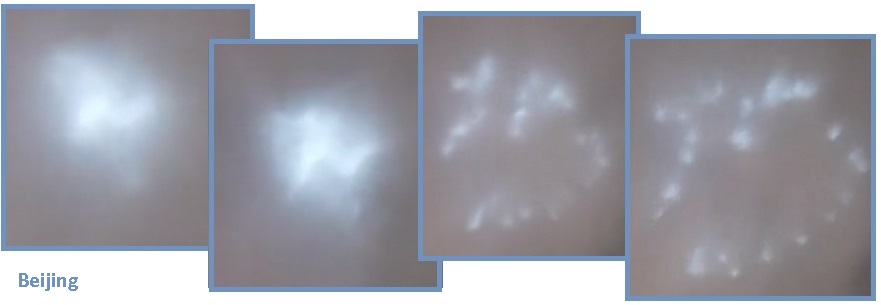
ZetaTalk Prediction
10/16/2022: During
any shattering of plates in this region Japan could anticipate
being slung from one side to the other, as depicted in the UFO
display there. Nearby on the Eurasian Plate, China also has a
platelet on the coastline and bordering the Okhotsk
Platelet the Amurian Platelet. The UFO display in
Beijing is showing an explosion, which any shattering of the
Eurasian Plate there would include. These would be major
earthquakes. Further south along the China coastline and just
across the water from Taiwan lies the Yangtze Plate. The UFO
display for Taiwan shows a bulge surrounded by swirling UFO's,
indicating that Taiwan could expect a counterclockwise motion
during these changes.
China has been in an intense stretch for over a year, with
melting roads showing the stress. China's unrelenting stress can
only be relieved, per the Zetas, by the tongue of the Sunda
Plate breaking off from the Great Eurasian Plate. The quake maps
are showing that this in process for the past month or more.
None of this is on the Jolt
Timeline graphic which has a local focus on the last steps
to the New Madrid Rupture whereas the 2010 Plate Movements was
the big picture, the overview, and it is still in effect.
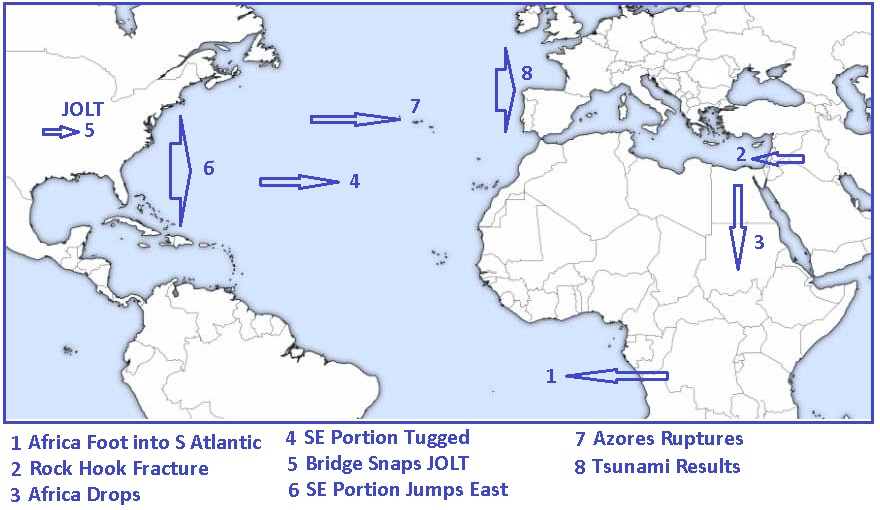
ZetaTalk Clarification
4/10/2023: The
problem with ZetaTalk readership expectations on the New
Madrid process is the exact definition of what 'it' is. In the
early days we described the New Madrid Fault Line rupture as
breaking bridges up along the Mississippi River and collapsing
structures along the Fault Line, with a void in the Atlantic
at the Azores causing a massive tsunami rolling up against
European shores. This is a process, with innumerable steps in
the timeline. When the Hard Rock Hotel collapsed in New
Orleans on October 27, 2019 we
stated that was the start of the process, and explained why
there had been delays.
In trying to give Obama time
to announce the presence of Nibiru, the Council of Worlds had
installed humming boxes and monoliths to delay Plate
Movements. These delays impacted schedules and timelines
elsewhere in the Universe and consequently the Council of
Worlds is now under great pressure to catch up and has
instituted a Severe Wobble
to do so. The New Madrid process is of intense interest
to those in America and Europe, and because it includes the
Africa Roll, to those in the Middle East too.
We are under restrictions not
to give dates, but rather a sequence of events. But this does
not stop mankind from seeing a date in our every statement.
After the Hard Rock Hotel collapsed, all eyes were on the
Mississippi Bridges and indeed on May
12, 2021 the Memphis bridge had a snap. To focus on the
bigger picture we switched to pointing to the Rock
Hook under Turkey, as until that snapped the Africa Roll
would not proceed and the roll was intrinsic to the process.
When the Rock Hook snapped on
December 13, 2022 turmoil in the
Middle East did indeed ensue, with Suez Canal traffic having
to be closed on a daily basis and the long-predicted Turkey
quakes creating devastation. Once again mankind,
anxious for a date, needed a focus. While the Fault Line in
the US was steadily separating, there was no specific focus.
But the pending China quake
began a dramatic appearance, and by prior UFO displays in
November, 2022 were confirmed by ourselves. This pending
quake will allow room for the SE Portion hook at the
isthmus to release, thus speeding the process to a Finale.
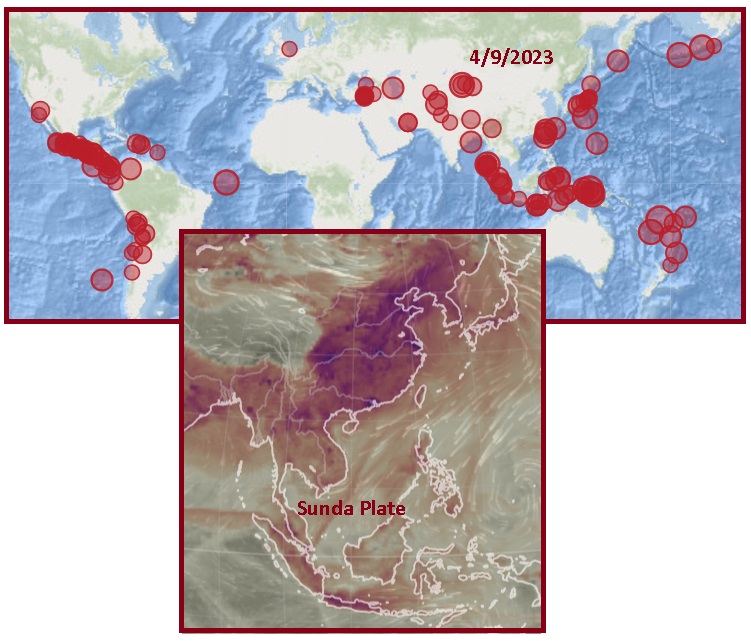
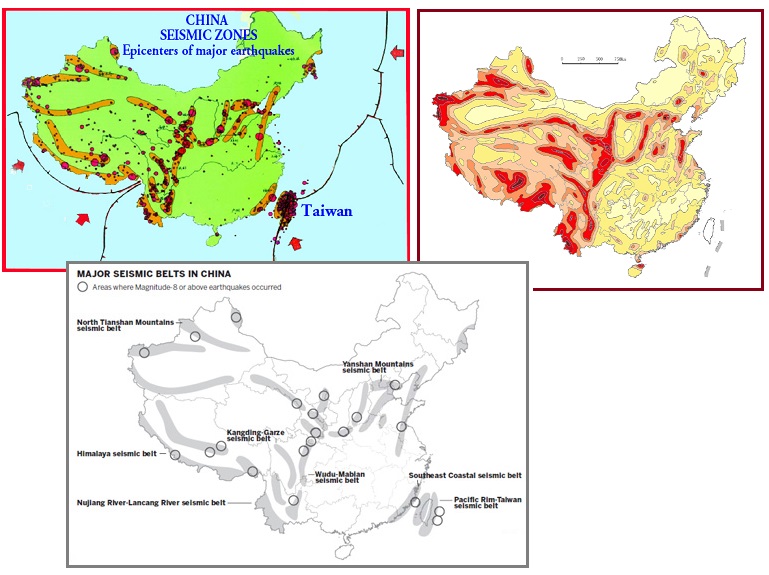
As we have noted, the Council of Worlds slowed the New Madrid
Rupture down so as to give Obama a chance to make the
announcement about Nibiru. Obama failed, lacking courage, in
2015. Meanwhile slowing had occurred due to the Humming
Boxes installed along plate borders and fault lines in N
America. This was also done as a result of the Monoliths
installed in N America.
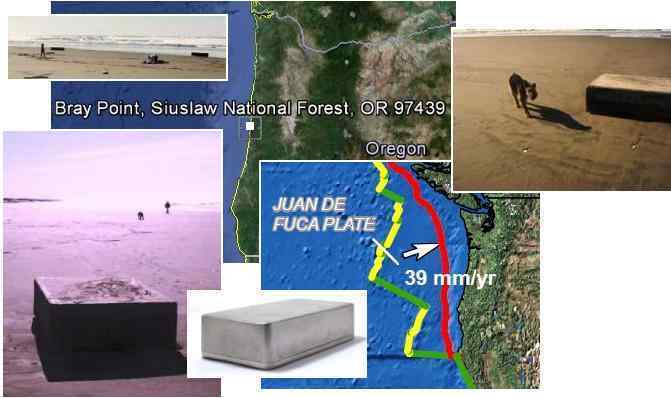
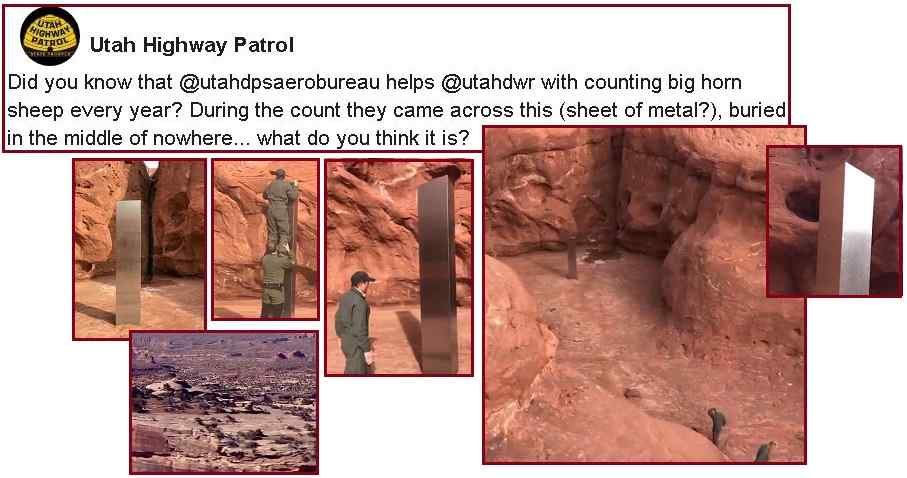
But there are celestial timelines beyond the Earth and by
slowing down the New Madrid process, the Council of Worlds was
scolded. They had to catch up, and are in the process of
doing so by effecting a Severe
Wobble since November 2021 to encourage Plate
Movement. Like a softball pitcher winding up before
releasing the ball, one gets momentum and direction established
first. This is happening now. The Severe Wobble being caused now
by the Council of Worlds is similar to the Severe Wobble of the
Last Weeks, but is only temporary and is less severe.
- Isaiah 24-20
https://biblehub.com/isaiah/24-20.htm
- 20: The earth staggers like a
drunkard and sways like a shack. Earth's rebellion weighs
it down, and it falls, never to rise again.
ZetaTalk Clarification
4/12/2023: As
we mentioned the Severe Wobble will be a trigger to incite the
Plate Movements necessary for the New Madrid event to occur.
The New Madrid event is dependent upon prior Plate Movements,
and as we have detailed this includes the Sunda Platelet
snapping off to become an independent plate, which allows
China to lurch into the Pacific, which thus compresses the
Pacific top to bottom so that the toe of S America has room to
pull into the Pacific, which tilts the S American Continent so
the bulbous top part along with the Caribbean lob into the
Atlantic, which releases the toe of the SE Portion so it can
lurch East.
This entire sequence of events
does not happen in a day and may involve iterative action at
all stages. The Sunda Plate is outlined in quakes and SO2 hot
with rock stress but China has not yet had any quakes as a
result. China has been so SO2 hot that its roads have been
melting. We have described the China quake as an implosion, a
large quake with extensive damage to China's interior. This
step in the timeline will not be missed, but the resulting
compression of the S Pacific involves action on the 4 Pacific
Plates, so is unlikely to complete all at once.
The tilting of S America will
also allow the foot of Africa to slide into the S Atlantic
expediting the Africa Roll. This combined with the SE Portion
finding its toe at the Isthmus to be freed will speed the
process. Many days may pass while the point of maximum
pressure on the Bridge holding the N American Portions
together is reached. This will be the last block needing to
give, and when it does, as we have repeatedly stated, the
Azores will instantly rip open to cause a tsunami racing
toward Europe.
Making Clothing
In the modern world when one needs clothing
or blankets it is a simple matter of a shopping trip. But
during the Pole Shift disaster predicted in a few short years,
shopping and distribution of goods will not be possible for
most. Eventually, even flea markets or barter exchange in
neighborhoods will run out of goods. What then? It is just a
matter of stepping back in time for
a couple hundred years, as during the time prior to the
Industrial Revolution, or living like the Amish do today.

Using a Spinning Wheel
and Loom to make cloth is a hobby these days, but with hand
tools these can be replicated anywhere. With wool or cotton,
card it into long fibers. Spinning a thread, a rope, or a strand
of yarn involves three steps - straightening the material to be
spun, putting a twist in a thin strand of the material, and
winding the twisted strand onto a bobbin. Material to be spun
can be any fibrous material such as wool from animals, flax and
cotton from plants, or silk from silk worms.
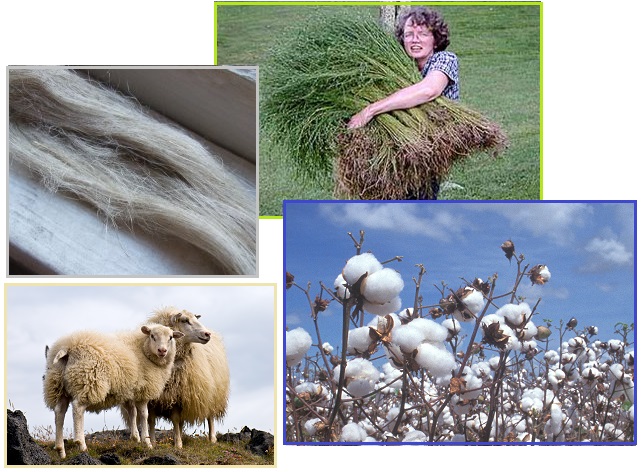
Preparing the material involves washing it, and in the case of
flax, soaking and working it in water to remove rotting soft
matter from the fibers. The clean fibers are then combed
straight or carded, an action where the fibers are caught
between two flat wire brushes, called cards, pulled in opposite
directions. In the most primitive form spinning is done with a
distaff and spindle, where the hand-held spindle is moved in a
circle by wrist movements and after a twist is put into the
thread, is wound by hand onto the spindle. This process is used
in one form or another in primitive cultures around the world.

The spinning wheel improves this process, allowing a foot pedal
to create the spin while the hands are free to work with the
material. The foot pedal is attached by a strap to a special
spoke sticking out from the center and to the side of the wheel.
When this special spoke is on the downward side of the circle,
the foot gives a gentle nudge to the foot pedal, encouraging the
motion. When on the upward side of the circle, the foot
releases, allowing the pedal to raise up so as not to slow the
motion of the wheel.
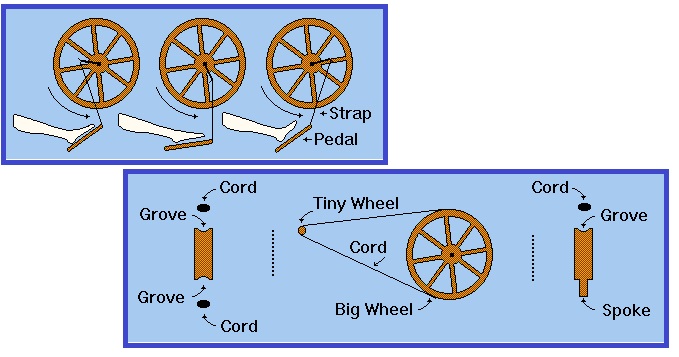
There is a groove in the wheel that holds a cord, and a similar
groove in a tiny wheel on the other end of the Spinning Wheel.
The relatively slow motion of the large wheel thus makes for
many turns of the tiny wheel, which is attached to the bobbin.
This bobbin replaces the more primitive spindle. Enough tension
is placed on the cord wrapped around the wheel and thence to the
bobbin so that the cord does not readily slip on either the
wheel or the bobbin. The knot in the cord should be as smooth as
possible.
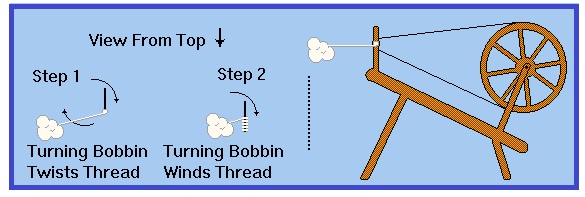
A portion of the clean and straightened fibers are hooked onto
the pointed end of the bobbin, and the turning motion begun. The
material is first drawn out gradually to a thin thread while
attached to the end of the bobbin. The spinning wheel now is
giving a twist to the thread. The drawing out of the material
should occur simultaneously to the twisting, so that the twist
climbs back toward the receding hand. When the material is
twisted to an arm's length, the thread is allowed to wind up
along the length of the bobbin, coming back to the tip for the
next thinning and twisting action. During twisting, a slight
tension holds the thread back from winding on the bobbin.
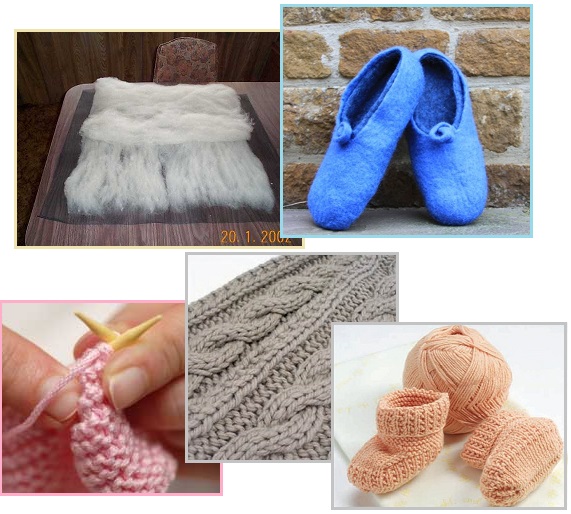
Cotton or wool fibers can also be used as yarn for knitting or
crocheting. Since wool tightens and shrinks when heated, a type
of cloth called felt can be made from small scraps. The felting
process is to lay wool fibers in different directions, then pour
boiling water over the lot. Felt is durable and wet felt can be
formed into slippers. Transforming natural materials into
clothing in this way has been done by idle hands in the evenings
around the fire for centuries.
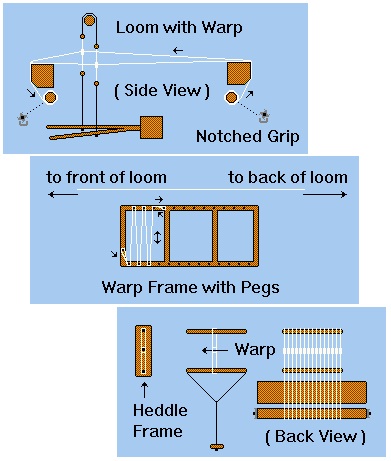
Once you have thread and yarn, you can weave cloth on a loom.
Looms can be large or small, producing heavy cloth or something
lightweight like linen. Once again, this is an item a carpenter
could construct with hand tools. Weaving requires two different
threads - the warp and the weft. The warp is long and strung
from the front to the back of the loom; the weft is laid from
side to side during the weaving process. Looms can be large,
several feet wide, or small enough to be placed on a table.
Cloth woven on a small loom can be sewn together to make a
larger piece.

The warp is long, runs from the front of the loom to the back,
and is wound around horizontal wooden bars at the front and
back. These bars turn, to wind the warp at the front end or
unwind the warp at the back, by using a simple notched grip
attached to the ends of the bars. The warp is strung by winding
a continuous thread around pegs on a warp frame. Wind the thread
back and forth several times, creating several warp threads at
one time, and then grip the bunch on both ends and transfer the
warp lengths to the loom frame. This is done repeatedly until
the warp is as wide as the loom or as wide as desired.
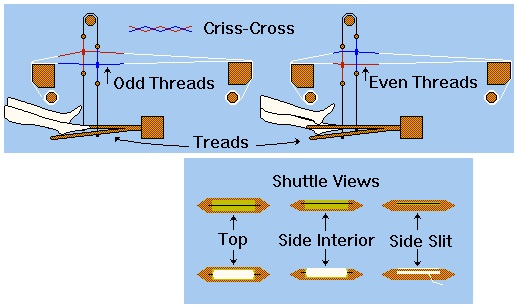
Make the warp as long as possible, as the very front and back of
the warp can never be woven and become waste or fringe. The warp
threads on the loom are threaded through heddles, which are also
made of string or thread. A heddle is in essence a small string
loop inside a larger string loop, with the small loop in the
middle to hold a warp thread so it can be raised or lowered
during the weaving process. The heddles are made on a heddle
frame composed of three nails on a board, the top loop tied
above the middle nail, then below the middle nail, then below
the bottom nail.
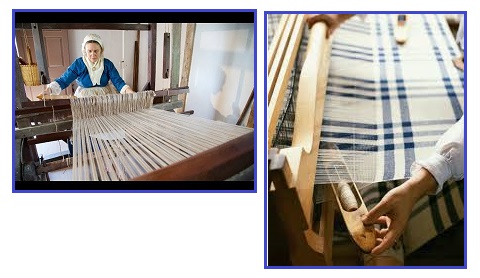
The warp threads are strung through the heddles in the two
heddle racks so that the odd warp threads go through the heddles
on one rack, and the even warp threads go through the heddles on
the second rack. Then, by pressing one tread or the other, the
warp threads are raised and lowered by a pulley action, creating
a crisscross that secures the weft threads passed back and forth
across the warp. The weft threads are wound onto a bobbin, a
metal rod, that is passed back and forth across the warp threads
inside a shuttle, as though they were sailing across the warp
threads inside a tiny boat. The shuttle is a size that can be
held in the hand, longer than wide, and the wood is smoothed to
avoid snagging during the weaving process. The shuttle has a
rectangle cut from the center where the filled bobbin is placed.
The metal rod of the bobbin is held in place by notches at the
ends of this hole. A slit is cut at the side where the weft
threads unwind.
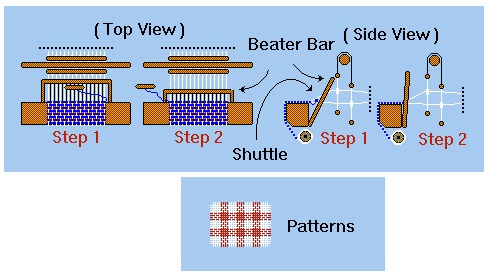
After the shuttle is passed and the weft thread pulled so there
is no slack, the beater bar is pulled forward to tap the weft
snug against the crisscross of the warp threads. Then the beater
bar is dropped back, away from the weaver, and the warp threads
reversed by the heddle pulley action controlled by the foot
treads. The beater bar has a thin wire or reed to go between
each warp thread, and is not used with force but a gentle
tapping action. Different patterns can be woven into the
material by alternating colors in the warp thread and using a
number of shuttles.

Curing leather to be used in coats or shoes or chaps is messy at
first, because the leather must be scraped clean. There are many
chemicals used for curing leather, but one survivors are almost
certain to be able to obtain is the time honored tannin from the
bark of many different trees. Some rivers even owe their dark
brown color not to mud but tannin from trees upstream. Soaking
the leather in a mash from the brains of the animal is another
tanning technique.
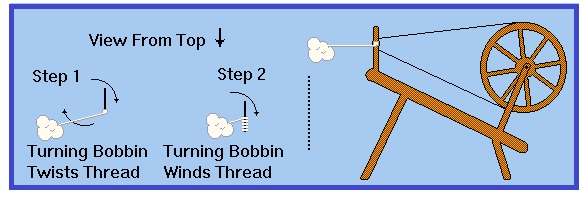
There is helpful information on the Troubled
Times pages to soften and cure hides, such as Rawhide,
Scraping, Dry
Scraping, Wet Scraping,
How Much, Brain
Tanning, Braining Steps,
Soap Tanning, Smoking,
Softening, Inuit
Women, and Bird Skins.
|

